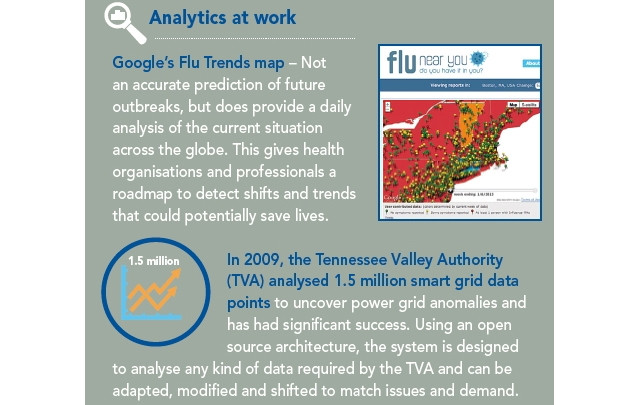
The ephemeral torrent of big data streaming across networks, mobiles, wires and inboxes every second of every day is a powerful source of information if harnessed correctly. Data technology continues to evolve, but its adoption is fragmented and much of the value inherent in all of this information is lost. Advanced analytics is the key to grabbing hold of this data and using it to make informed business decisions, transforming the way organisations plan, interact and grow. "Advanced analytics is the extensive use of data, statistical and predictive models and other kinds of business simulation alongside daily, fact-based management to drive decisions and actions," says Suren Govender, MD of Accenture Analytics. "Our clients face some real challenges in their businesses today and with advanced analytics, we assist them in harnessing and using diverse data sources at their disposal to give them a real competitive edge in their industries."
Delving into the depths of advanced analytics provides the organisation with significant advantages. It can refine productivity and efficiency through improved operational intelligence and near real-time responses. Insight is shared across enterprise silos, building comprehensive overviews of both structured and unstructured data. It can improve return on investment and inspire innovation throughout the enterprise with visualisation and the elimination of redundant infrastructure.
"Advanced analytics offers a future-oriented analysis that can be used to drive change in business practice and business models," says Dr Corine Van Erkom Schurink, Advanced Analytics team leader, PBT Group. "This allows the organisation to not only paint the picture of yesterday and today, the traditional role of business intelligence, but also of the future."
According to the Hurwitz Victory Index Report for Advanced Analytics, this process has the ability to predict customer behaviour and preferences, forecast sales and industry trends, machinery failure and even trends in fraud. The research has found that pharmacies and drug companies are using advanced analytics to predict the scope of the flu season so they can stock up on specific products in advance. And farms are using the technology to manage planting times, improve crop yields and plan harvests.
Rethink, simplify
In South Africa, the Care Cross Health Group partnered with QlikView to support its management and extensive use of healthcare professionals and pharmacies. The group needed to control its financial risk through analytics, and used the solution to focus on physician compliance, micro-manage performance and mitigate reputational risk. The company saved nearly R3 million on cost of sales by working with physicians and has used the analytics solution to improve chronic medication and drug compliance within specific groups of patients.
"Advanced analytics establishes what is happening, why it's happening and what may happen," says Davide Hanan, MD of Qlikview South Africa. "This combination of descriptive, diagnostic and predictive capabilities enables businesses to keep doing what works well and to fix what doesn't."
Govender believes that by 2017, over 50 percent of analytics implementations will make use of event data streams generated from instrumented machines, applications and individuals. And these data streams look set to only become more prolific as devices become less expensive and more connected, and users become attuned to how seamlessly real-time analytics can inform their experiences.
"The current digital revolution is re-imagining the human experience," adds Govender. "It's remaking how people live, work, play and connect. Everything is being rethought, simplified and improved - even things people have taken for granted throughout their lives."
Advanced analytics allows the organisation to not only paint the picture of yesterday and today, the traditional role of business intelligence, but also of the future.
Dr Corine Van Erkom Schurink, PBT Group
Advanced analytics is being used to create remarkable maps that examine human behaviour (customer flow), flu activity and so much more. Its potential is fantastic, yet adoption remains low. According to the Deloitte CIO Survey 2014, more than 50 percent of CIOs are not piloting, implementing or adopting analytics in their organisations. This is likely to change as the value of advanced analytics continues to grow, and the technologies behind it become more cost-effective and mainstream. For now, however, organisations that have already stepped behind the velvet curtain and into the world of the data crystal ball will have the advantage.

This article was first published in Brainstorm magazine. Click here to read the complete article at the Brainstorm website.
Share